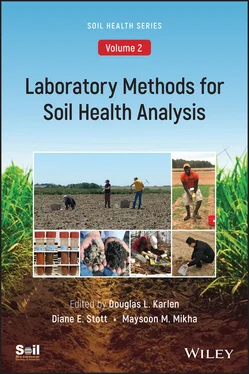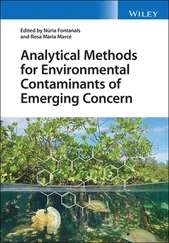Laboratory Methods for Soil Health Analysis, Volume 2
Здесь есть возможность читать онлайн «Laboratory Methods for Soil Health Analysis, Volume 2» — ознакомительный отрывок электронной книги совершенно бесплатно, а после прочтения отрывка купить полную версию. В некоторых случаях можно слушать аудио, скачать через торрент в формате fb2 и присутствует краткое содержание. Жанр: unrecognised, на английском языке. Описание произведения, (предисловие) а так же отзывы посетителей доступны на портале библиотеки ЛибКат.
- Название:Laboratory Methods for Soil Health Analysis, Volume 2
- Автор:
- Жанр:
- Год:неизвестен
- ISBN:нет данных
- Рейтинг книги:3 / 5. Голосов: 1
-
Избранное:Добавить в избранное
- Отзывы:
-
Ваша оценка:
- 60
- 1
- 2
- 3
- 4
- 5
Laboratory Methods for Soil Health Analysis, Volume 2: краткое содержание, описание и аннотация
Предлагаем к чтению аннотацию, описание, краткое содержание или предисловие (зависит от того, что написал сам автор книги «Laboratory Methods for Soil Health Analysis, Volume 2»). Если вы не нашли необходимую информацию о книге — напишите в комментариях, мы постараемся отыскать её.
Analyzing, comparing, and understanding soil health data Soil Health, Volume Two: Laboratory Methods for Soil Health Analysis
Laboratory Methods for Soil Health Analysis, Volume 2 — читать онлайн ознакомительный отрывок
Ниже представлен текст книги, разбитый по страницам. Система сохранения места последней прочитанной страницы, позволяет с удобством читать онлайн бесплатно книгу «Laboratory Methods for Soil Health Analysis, Volume 2», без необходимости каждый раз заново искать на чём Вы остановились. Поставьте закладку, и сможете в любой момент перейти на страницу, на которой закончили чтение.
Интервал:
Закладка:
One example of laboratory validation is offered through the North American Proficiency Testing (NAPT) Program delivered by the Soil Science Society of America. The NAPT program supports soil, plant, and water testing laboratories by providing interlaboratory sample exchanges and statistical analyses of data. American and Canadian experts from scientific organizations, state (U.S.) and provincial (Canada) departments of agriculture, regional working groups, and public and private analytical labs provide organization and oversight (SSSA, 2020).
Table 1.2 Tier 2 Soil Health Indicators and Methods to be Assessed
| Indicator | Method | Reference |
|---|---|---|
| Sodium Adsorption Ratio (SAR) | Saturated paste extract followed by atomic absorption or inductively coupled plasma spectroscopy | Miller et al., 2013 |
| Soil Stability Index | Combination of wet and dry sieving at multiple sieve sizes | Franzluebbers et al., 2000 |
| Active Carbon | Permanganate oxidizable carbon (POXC). Digestion followed by colorimetric measurement | Weil et al., 2003 |
| Soil Protein Index | Autoclaved citrate extractable | Schindelbeck et al., 2016 |
| B‐Glucosidase | Assay incubation followed by colorimetric measurement | Tabatabai, 1994 |
| N‐acetyl‐B‐D‐glucosaminidase | Assay incubation followed by colorimetric measurement | Deng and Popova, 2011 |
| Phosphomonoesterase | Assay incubation followed by colorimetric measurement | Acosta‐Martínez and Tabatabai, 2011 |
| Arylsulfatase | Assay incubation followed by colorimetric measurement | Klose et al., 2011 |
| Phospholipid Fatty Acid (PLFA) | Bligh‐Dyer extractant, solid phase extraction, transesterification; gas chromatography | Buyer and Sasser, 2012 |
| Genomics | 18S, 16S or ITS analysis or a combination of 16S and 18S/ITS and/or shotgun metagenomics | Earth Microbiome Project 500; Marotz et al., 2017 Thompson et al., 2017 |
| Reflectance | Diffuse reflectance spectroscopy | Veum et al., 2015 |
Several layers of certifications or validations may be in place to ensure data quality for commercial analytical labs. For example, the Agricultural Laboratory Proficiency (ALP) Program provides soil samples to laboratories for analysis and then assesses that laboratory’s results relative to the test soil’s known properties. In turn, the ALP program is accredited by the American National Standards Institute/American Society of Quality Control National Accrediting Board (ANAB) through testing of ISO/IEC 17043, itself an international standard of the International Organization for Standardization and the International Electrotechnical Commission for laboratory proficiency testing that determines the performance of individual laboratories for specific tests or measurements and is used to monitor laboratories’ continuing performance through interlaboratory comparisons. Thus, commercial laboratories conducting analyses for soil health indicators select measurements and indicators that are understood in the research community to relate to processes in soil important to soil health; and methods that are affordable to the farming community, as well as verifiable for accuracy and precision (= reliability to the producer) by independent tests.
Summary and Conclusions
This introduction to Volume II provides those interested in soil health assessment methods a brief background regarding identification and selection of the indicators within this volume and to provide context regarding current and future soil health assessment efforts. It also demonstrates that multiple groups ( i.e ., SHI and the NRCS‐SHD) that engaged in workshops and conferences during 2013 to 2015 continue to coordinate soil health assessments to protect and enhance our fragile, yet life‐sustaining soil resource for current and future generations.
References
1 Acosta‐Martínez, V., and Tabatabai, M.A. (2011). Phosphorus cycle enzymes. In R.P. Dick, (ed.), Methods of soil enzymology. Madison, WI: SSSA. doi:10.2136/sssabookser9.c8.
2 Blake, G.R., and Hartge, K.H. (1986). Bulk density. In: A. Klute (ed.), Methods of soil analysis: Part 1. Physical and mineralogical methods (p. 363–382). 2nd ed. Madison, WI: ASA and SSSA.
3 Brevik, E.C. (2018). A brief history of the soil health concept. The Profile. Madison, WI: Soil Science Society of America. Posted 18 Dec. https://profile.soils.org/files/soil‐communication/documents/95_document1_d50a8524‐dbf4‐4856‐8c62‐4a03ede6c3d4.pdf(Accessed 20 Feb. 2020).
4 Bundy, L.G., and Meisinger, J.J. (1994). Nitrogen availability indices. In R.W. Weaver, S. Angle, P. Bottomley, D. Bezdicek, S. Smith, A. Tabatabai, and A. Wollum, (eds.), Methods of soil analysis. Part 2 (p. 951–984). SSSA Book Ser. 5. SSSA, Madison, WI.
5 Buyer, J.S., and Sasser, M. (2012). High throughput phospholipid fatty acid analysis of soils. Appl. Soil Ecol. 61, 127–130. doi:10.1016/j.apsoil.2012.06.005
6 Deng, S., and Popova, I. (2011). Carbohydrate hydrolases. In R.P. Dick, (ed.), Methods of soil enzymology (p. 185–209). SSSA, Madison, WI.
7 Emerson, W.W. (1995). Water retention, organic‐C, and soil texture. Aust. J. Soil Res. 33, 241–251. doi:10.1071/SR9950241
8 Fajardo, M., McBratney, A.B., Field, D.J., and Minasny, B. (2016). Soil slaking assessment using image recognition. Soil Tillage Res. 163, 119–129. doi:10.1016/j.still.2016.05.018
9 Franzluebbers, A.J., Wright, S.F., and Stuedemann, J.A. (2000). Soil aggregation and glomalin under pastures in the Southern Piedmont USA. Soil Sci. Soc. Am. J. 64, 1018–1026. doi:10.2136/sssaj2000.6431018x
10 Gee, G.W., and Bauder, J.W. (1986). Particle‐size analysis. In A. Klute, (ed.), Methods of soil analysis. Part 1– Physical and mineralogical methods (p. 493–544). 2nd ed. Madison, WI: ASA and SSSA.
11 Hudson, B.D. (1994). Soil organic matter and available water capacity. J. Soil Water Conserv. 49, 189–194.
12 Ismail, I., Blevins, R.L., and Frye, W.W. (1994). Long‐term notillage effects on soil properties and continuous corn yields. Soil Sci. Soc. Am. J. 58:193–198. doi:10.2136/sssaj1994.03615995005800010028x
13 Karlen, D.L., Wollenhaupt, N.C., Erbach, D.C., Berry, E.C., Swan, J.B., Eash, N.S., and Jordahl, J.L. (1994). Long‐term tillage effects on soil quality. Soil Tillage Res. 32, 313–327. doi:10.1016/0167‐1987(94)00427‐G
14 Karlen, D.L., Stott, D.E., Cambardella, C.A., Kremer, R.J., King, K.W., and McCarty, G.W. (2014). Surface soil quality in five midwestern cropland Conservation Effects Assessment Project watersheds. J. Soil Water Conserv. 69, 393–401. doi:10.2489/jswc.69.5.393
15 Kemper, W.D., and Roseneau, R.C. (1986). Aggregate stability and size distribution. In: A. Klute, editor, Methods of soil analysis: Part I. Physical and mineralogical methods (p. 425–442). 2nd ed. Madison, WI: ASA and SSSA.
16 Klute, A. (1986). Water retention: Laboratory methods. In: A. Klute, editor, Methods of soil analysis: Part 1. Physical and mineralogical methods (p. 635–662). 2nd ed. Madison, WI: ASA and SSSA. doi:10.2136/sssabookser5.1.2ed
17 Klose, S., Bilen, S., Tabatabai, M.A., and Dick, W.A. (2011). Sulfur cycle enzymes. In R.P. Dick, (ed.), Methods of soil enzymology (p. 125–159). Madison, WI: SSSA.
18 Knudsen, D., Peterson, G.A., and Pratt, P.F. (1982). Lithium, sodium and potassium. In A.L. Page (ed.), Methods of soil analysis. Part 2. 2nd ed. Madison, WI: ASA and SSSA.
Читать дальшеИнтервал:
Закладка:
Похожие книги на «Laboratory Methods for Soil Health Analysis, Volume 2»
Представляем Вашему вниманию похожие книги на «Laboratory Methods for Soil Health Analysis, Volume 2» списком для выбора. Мы отобрали схожую по названию и смыслу литературу в надежде предоставить читателям больше вариантов отыскать новые, интересные, ещё непрочитанные произведения.
Обсуждение, отзывы о книге «Laboratory Methods for Soil Health Analysis, Volume 2» и просто собственные мнения читателей. Оставьте ваши комментарии, напишите, что Вы думаете о произведении, его смысле или главных героях. Укажите что конкретно понравилось, а что нет, и почему Вы так считаете.












